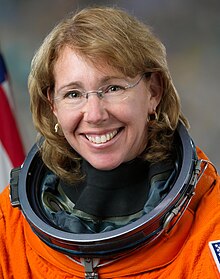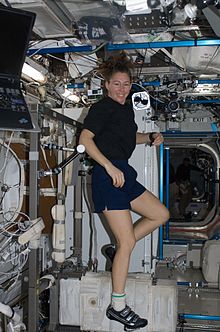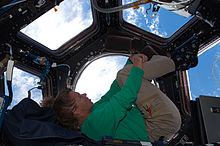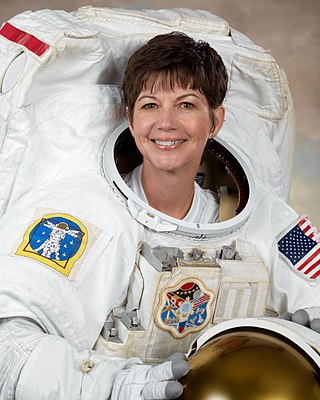
Catherine Grace "Cady" Coleman is an American chemist, engineer, former United States Air Force colonel, and retired NASA astronaut. She is a veteran of two Space Shuttle missions, and departed the International Space Station on May 23, 2011, as a crew member of Expedition 27 after logging 159 days in space.

Robert Brent "Bob" Thirsk, is a Canadian retired engineer and physician, and a former Canadian Space Agency astronaut. He holds the Canadian record for the most time spent in space. He became an officer of the Order of Canada (OC) in 2013 and was named to the Order of British Columbia (OBC) in 2012.

Michael López-Alegría is an astronaut, test pilot and commercial astronaut with dual nationality, American and Spanish; a veteran of three Space Shuttle missions and one International Space Station mission. He is known for having performed ten spacewalks so far in his career, presently holding the second longest all-time EVA duration record and having the fifth-longest spaceflight of any American at the length of 215 days; this time was spent on board the ISS from September 18, 2006, to April 21, 2007. López-Alegría commanded Axiom-1, the first ever all-private team of commercial astronaut mission to the International Space Station, which launched on April 8, 2022, and spent just over 17 days in Earth's orbit.

Daniel Charles Brandenstein is the Executive Vice President and Chief Operating Officer of United Space Alliance. He is a former Naval Aviator, test pilot and NASA astronaut, who flew four Space Shuttle missions. He also served as Chief of the Astronaut Office from 1987 to 1992.

Michael Landon Gernhardt is a NASA astronaut and manager of the Environmental Physiology Laboratory, and principal investigator of the Prebreathe Reduction Program (PRP) at the Lyndon B. Johnson Space Center.

James Shelton Voss is a retired United States Army colonel and NASA astronaut. During his time with NASA, Voss flew in space five times on board the Space Shuttle and International Space Station. He also served as deputy of Flight Operations for the Space Station Program Mission Integration and Operations Office. While participating in ISS Expedition 2, he and Susan Helms conducted an 8-hour and 56 minute spacewalk, the longest to date.

Rex Joseph Walheim is a retired United States Air Force officer, engineer and NASA astronaut. He flew three Space Shuttle missions, STS-110, STS-122, and STS-135. Walheim logged over 566 hours in space, including 36 hours and 23 minutes of spacewalk (EVA) time. He was assigned as mission specialist and flight engineer on STS-135, the final Space Shuttle mission.

Stephanie Diana Wilson is an American engineer and a NASA astronaut. She flew to space onboard three Space Shuttle missions, and is the second African American woman to go into space, after Mae Jemison. As of 2022, her 42 days in space are the second most of any female African American astronaut, having been surpassed by Jessica Watkins in 2022, however in 2024 she was assigned to the Crew-9 mission during which she should retake the lead.
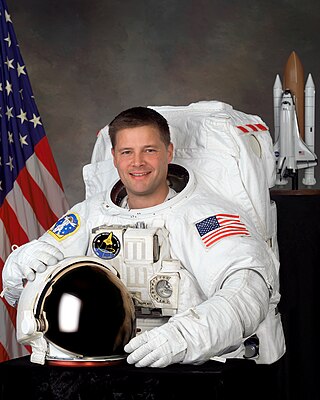
Douglas Harry "Wheels" Wheelock is an American engineer and astronaut. He has flown in space twice, logging 178 days on the Space Shuttle, International Space Station, and Russian Soyuz. On July 12, 2011, Wheelock announced that he would be returning to active duty with the United States Army in support of Operation Enduring Freedom. He is currently working with NASA to test the Orion spacecraft at the Glenn Research Center in Plum Brook, Ohio.

Timothy Lennart "Tim" Kopra is an engineer, a Colonel in the United States Army and a retired NASA astronaut. He served aboard the International Space Station as a flight engineer for Expedition 20, returning to Earth aboard Space Shuttle Discovery on the STS-128 mission on September 11, 2009. He returned to the ISS for the second time in December 2015, as part of Expedition 46 and as the commander of 47.

Clayton Conrad Anderson is a retired NASA astronaut. Launched on STS-117, he replaced Sunita Williams on June 10, 2007, as a member of the ISS Expedition 15 crew. He is currently an author, a motivational speaker, and a Professor of Practice at Iowa State University in Ames, Iowa. In 2022 he became the president and CEO of the Strategic Air Command & Aerospace Museum.
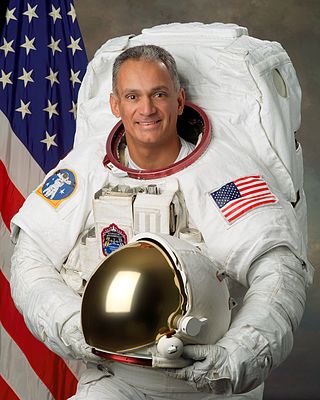
John Daniel "Danny" Olivas is an American engineer and a former NASA astronaut. Olivas has flown on two space shuttle missions, STS-117 and STS-128. He performed EVAs on both missions, totaling 34hrs 28min.

Garrett Erin Reisman is an American engineer and former NASA astronaut. He was a backup crew member for Expedition 15 and joined Expedition 16 aboard the International Space Station for a short time before becoming a member of Expedition 17. He returned to Earth on June 14, 2008 on board STS-124 on Space Shuttle Discovery. He was a member of the STS-132 mission that traveled to the International Space Station aboard Space Shuttle Atlantis from May 14 to 26, 2010. He is a consultant at SpaceX and a Professor of Astronautics Practice at the University of Southern California's Viterbi School of Engineering.

Gregory Errol Chamitoff is a Canadian-born American engineer and former NASA astronaut. He has been to space twice, spending 6 months aboard the ISS across Expedition 17 and 18 in 2008, and another 15 days as part of STS-134 in 2011. STS-134 was the last of Space Shuttle Endeavour which delivered the Alpha Magnetic Spectrometer and completed the US Orbital Segment.

Karen LuJean Nyberg is an American mechanical engineer and retired NASA astronaut. Nyberg became the 50th woman in space on her first mission in 2008. Nyberg holds a Ph.D in mechanical engineering. She started her space career in 1991 and spent a total of 180 days in space in 2008 and 2013 as a mission specialist on STS-124 and a flight engineer on Soyuz TMA-09M.

Shannon Walker is an American physicist and a NASA astronaut selected in 2004. She launched on her first mission into space on June 25, 2010, onboard Soyuz TMA-19 and spent over 163 days in space.

Nicole Marie Passonno Stott is an American engineer and a retired NASA astronaut. She served as a flight engineer on ISS Expedition 20 and Expedition 21 and was a mission specialist on STS-128 and STS-133. After 27 years of working at NASA, the space agency announced her retirement effective June 1, 2015. She is married to Christopher Stott, a Manx-born American space entrepreneur.
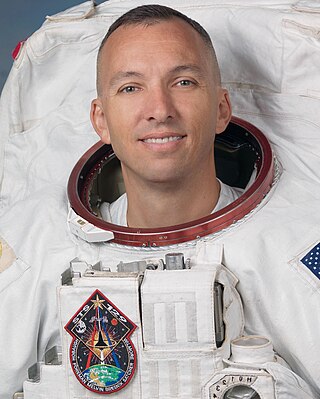
Randolph James "Komrade" Bresnik is a retired officer in the United States Marine Corps and an active NASA astronaut. A Marine Aviator by trade, Bresnik was selected as a member of NASA Astronaut Group 19 in May 2004. He first launched to space on STS-129, then served as flight engineer for Expedition 52, and as ISS commander for Expedition 53.

Michael Reed Barratt is an American physician and a NASA astronaut. Specializing in aerospace medicine, he served as a flight surgeon for NASA before his selection as an astronaut and has played a role in developing NASA's space medicine programs for both the Shuttle-Mir Program and International Space Station. His first spaceflight was a long-duration mission to the International Space Station, as a flight engineer in the Expedition 19 and 20 crew. In March 2011, Barratt completed his second spaceflight as a crew member of STS-133. Barratt pilots the SpaceX Crew-8 mission that launched on 4 March 2024.

Robert Louis Behnken is an American engineer, a former NASA astronaut, and former Chief of the Astronaut Office.
